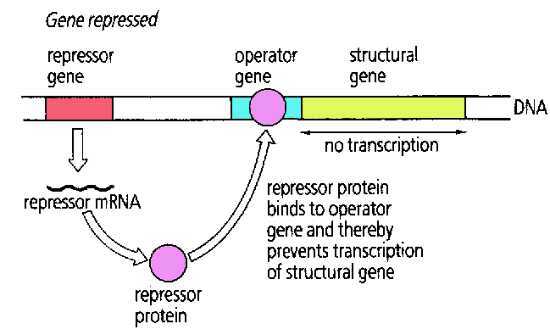
Gene induced model
( Diagram adopted from : A-Level Biology, by Phillips and Chilton, Oxford University Press, 1989, pp. 59)
| (1) | The structural gene is the gene encoding the primary structure of a protein. It may be involved in the bodily structure or operation of the body. So, when it is activated, it would be transcribed into its mRNA and translates into the corresponding protein. Once this gene is activated, the corresponding protein will be produced in that location. |
| (2) | The operator gene is the part of the gene that is always activated and then, producing an activator. So, the activator can always activate the structural gene and enable the structural gene to be transcribed and translated. |
| (3) | The regulator gene is the part that would be continually transcribed and translated into a repressor. This repressor would act on the activator produced by the operator gene. Once the activator is sremoved from the structural gene, the transcription of the structural gene would be stopped. The production of the corresponding protein would be terminated. Then, it is said that the gene is inhibited. |

In Environment | |
| Repressor represses the operator gene | Lactose combines with repressor. Repressor cannot repress the operator gene. |
| Operator gene cannot activate structural gene | Operator gene continues to activate the structural gene. |
| Structure gene cannot have transcription and translation | Structural gene is transcribed and translated. |
| No beta galactosidase is produced. | Beta galactosidase is produced. |
| Lactose is decomposed. | |
| When lactose is exhausted, no lactose is in environment. | |
| Repressor is released to inhibit the operator gene. | |
| Operator gene cannot activate the structural gene. | |
| Structural gene stops transcription, translation. No beta galactosidase is in environment. | |

| Tryptophan combines with the repress to become a functional repressor. | The repressor is incomplete and not functional. |
| The tryptophan repressor complex successfully represses the operator gene. | The operator gene is not repressed. |
| The structural gene is not activated. No transcription and no translation occur. | The operator gene activates the structural gene. The structural gene is then transcribed and translated. |
| Tryptophan synthetase is not produced. | Tryptophan synthetase is produced. |
| No tryptophan is synthesized. | Tryptophan is synthesized. |